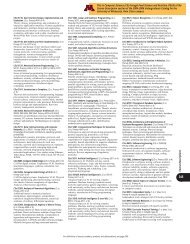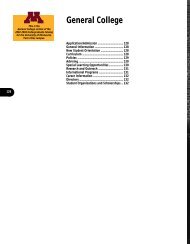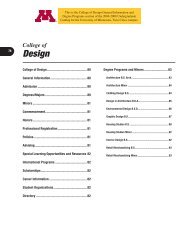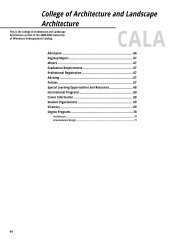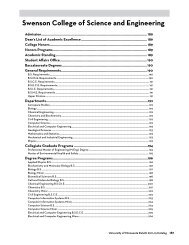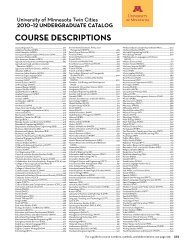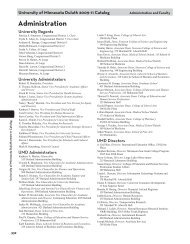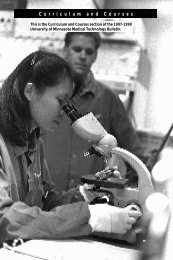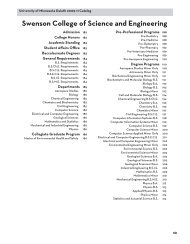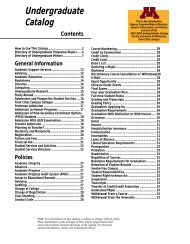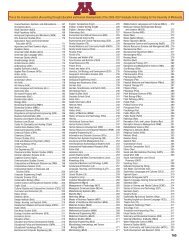CoursesâA through G and course numbers and symbols key
CoursesâA through G and course numbers and symbols key
CoursesâA through G and course numbers and symbols key
- No tags were found...
Create successful ePaper yourself
Turn your PDF publications into a flip-book with our unique Google optimized e-Paper software.
Chem 5210. Materials Characterization. (4 cr;A-F only. Prereq–Graduate student or #)Modern tools/techniques for both bulk- <strong>and</strong> thin-filmcharacterization. Topics may include ion-solidinteractions, Rutherford back scattering, secondaryion mass spectrometry, solid-state NMR, X-rayphotoelectron spectroscopy, small-angle X-ray/neutron scattering, transmission/scanning electron/probe microscopy, near-field scanning opticalmicroscopy, porosimetry, adsorption techniques, <strong>and</strong>ellipsometry.Chem 5221. Introduction to Polymer Chemistry.(3 cr. §MatS 5221. Prereq–[2302, 3501] or #)Condensation, radical, ionic, emulsion, ring-opening,metal-catalyzed polymerizations. Chainconformation, solution thermodynamics, molecularweight characterization, physical properties.Chem 5223W. Polymer Laboratory. (2 cr. §MatS 5223.Prereq–[5221 or 8211] or #)Synthesis, characterization, <strong>and</strong> physical propertiesof polymers. Free radical, condensation, emulsion,anionic polymerization. Infrared spectroscopy/gelpermeation chromatography. Viscoelasticity, rubberelasticity, crystallization.Chem 5311. Chemistry of Industry. (3 cr.Prereq–Chem sr or grad student or #)Industrial <strong>and</strong> polymer chemistry technology.Relation of basic properties to industrial utility.Economics, social problems, industrial environment.Chem 5321. Organic Synthesis. (3 cr. Prereq–[2302 orequiv], #)Fundamental concepts, reactions, reagents,structural/stereochemical issues, <strong>and</strong> mechanisticskills for organic chemistry.Chem 5322. Advanced Organic Chemistry. (3 cr.Prereq–2302 or equiv)Topics vary, including natural products, heterocycles,asymmetric synthesis, organometallic chemistry, <strong>and</strong>polymer chemistry. (See instructor for details.)Chem 5352. Physical Organic Chemistry. (3 cr.Prereq–2302, [5011 or 8011])Fundamental concepts <strong>and</strong> mechanistic tools foranalysis of organic reaction mechanisms. Solvation,reactive intermediates, gas phase chemistry,photochemistry or strained-ring chemistry or both.Chem 5361. Interpretation of Organic Spectra. (3 cr.Prereq–2302 or equiv)Application of nuclear magnetic resonance, mass,ultraviolet, <strong>and</strong> infrared spectral analyses to organicstructural problems.Chem 5412. Enzyme Mechanisms. (3 cr. Prereq–2302or equiv)Enzyme classification with examples from currentliterature; strategies to decipher enzymemechanisms; chemical approaches to control enzymecatalysis.Chem 5413. Nucleic Acids. (3 cr. Prereq–2302 or equiv)Chemistry <strong>and</strong> biology of nucleic acids. Structure,thermodynamics, reactivity, DNA repair, chemicaloligonucleotide synthesis, antisense approaches,ribozymes, techniques for nucleic acid research,interactions with small molecules <strong>and</strong> proteins.Chem 5715. Physical Inorganic Chemistry. (3 cr.Prereq–4701 or equiv, chem major or #)Physical methods (e.g., IR, UV-VIS, ESR,Mossbauer <strong>and</strong> mass spectroscopy, magneticmeasurements, X-ray diffraction) <strong>and</strong> conceptsapplied to inorganic <strong>and</strong> organometallic systems.Chem 5725. Organometallic Chemistry. (3 cr.Prereq–4701 or equiv, chem major or #)Synthesis, reactions, structures, <strong>and</strong> other propertiesof main group <strong>and</strong> transition metal organometalliccompounds; electronic <strong>and</strong> structural theory,emphasizing their use as stoichiometric <strong>and</strong>homogeneous catalytic reagents in organic <strong>and</strong>inorganic systems.Chem 5735. Bioinorganic Chemistry. (3 cr.Prereq–4701 or equiv, chem grad or #)Role of metal ions in biology. Emphasizes structure,function, <strong>and</strong> spectroscopy of metalloproteins <strong>and</strong>their synthetic analogs.Chem 5745. Advanced Inorganic Chemistry. (3 cr.Prereq–4701, chem major, #)Topics in main group <strong>and</strong> transition metal chemistry.Emphasizes synthesis, structure, physical properties,<strong>and</strong> chemical reactivity.Chem 5755. X-Ray Crystallography. (4 cr; A-F only.Prereq–Chem grad student or #)Essentials of crystallography as applied to modern,single crystal X-ray diffraction methods. Practicaltraining in use of instrumentation in X-raycrystallography facility in Department of Chemistry.Date collection, correction/refinement, structuresolutions, generation of publication materials, use ofCambridge Crystallographic Structure Database.Chicano Studies (Chic)Department of Chicano StudiesCollege of Liberal ArtsChic 1105. Introduction to Chicana/o Studies: TheBeginnings to 1875. (3 cr)Convergence of Europe <strong>and</strong> America inMesoamerica <strong>and</strong> the formation of Mexican society.Literary, social, cultural, <strong>and</strong> historical perspectives.Pre-Columbian period to 1875.Chic 1105H. Honors: Introduction to Chicana/oStudies: Beginnings to 1875. (4 cr. §1105.Prereq–Honors)Convergence of Europe, America in Mesoamerica.Formation of Mexican society. Literary, social,cultural, historical perspectives. Pre-Columbianperiod to 1875.Chic 1106. Introduction to Chicana/o Studies:Mexico <strong>and</strong> the United States From 1871 to Present.(3 cr)Convergence of Spanish-Mexican/Anglo-Americansocieties in Spanish borderl<strong>and</strong>s. Formation ofcontemporary Chicano political, economic, <strong>and</strong>cultural consciousness; forms in which it has beenexpressed.Chic 1106H. Honors: Introduction to Chicana/oStudies: Mexico <strong>and</strong> the United States From 1871 toPresent. (4 cr. §1106. Prereq–Honors)Convergence of Spanish-Mexican/Anglo-Americansocieties in Spanish borderl<strong>and</strong>s. Formation ofcontemporary Chicano political, economic, culturalconsciousness; forms in which it has been expressed.Chic 3114. International Perspectives: U.S.-MexicoBorder Cultures. (3 cr)The relations of Mexico <strong>and</strong> the United States froman international perspective with central focus on thecultural interchange in the borderl<strong>and</strong>s betweenthem; using both literary <strong>and</strong> historical materials.Chic 3212. La Chicana. (3 cr)This class centers on Chicanas or politically definedwomen of the Mexican American community. Ourmethod is interdisciplinary. It emphasizes theimportance of historical context <strong>and</strong> cultural processto any discussion of the Chicana experience.Chic 3375. Folklore of Greater Mexico. (3 cr)Scholarly survey <strong>and</strong> exploration of the socioculturalfunction of various types of folklore in GreaterMexico. Students analyze the ways in which folkloreconstructs <strong>and</strong> maintains community, as well asresists <strong>and</strong> engenders cultural shifts.Chic 3402. Las Mujeres. (3 cr)Focus on Chicanas; women of the MexicanAmerican community. Exploration of racial,economic, political, <strong>and</strong> gender issues of concern toall Mexican Americans <strong>and</strong> diverse Latino cultures.Chic 3427. History of Cuba <strong>and</strong> Puerto Rico. (3 cr)Historical development of Cuba <strong>and</strong> Puerto Ricofrom pre-Columbian times <strong>through</strong> the Spanishconquest to the present. Conquest <strong>and</strong> colonization,slavery, Hispanic Caribbean society <strong>and</strong> culture,Operation Bootstrap, Cuban Revolution.Course DescriptionsChic 3428. History of Relations Between U.S. <strong>and</strong>Mexico: 1821 to Present. (3 cr)U.S.-Mexico relations in the 19th <strong>and</strong> 20th centuries;examining histories as they intersect in the late1820s; loss of Texas; Mexican-American War;economic relations between the two countriesincluding NAFTA <strong>and</strong> the Chiapas rebellion of 1994.Chic 3441. Chicana/o History to 1900. (3 cr)History of the Mexican people from the 16th <strong>through</strong>19th centuries. Historical theories of colonialism,expansion, economy, assimilation, migration, <strong>and</strong>settlement; race, class, <strong>and</strong> gender; political, social,<strong>and</strong> cultural interaction <strong>and</strong> conflict.Chic 3442. Chicana/o History: 1900 to Present. (3 cr)Migration, repatriation, the Bracero program,politics, the Chicana/o movement, work, society, <strong>and</strong>culture.Chic 3507. Introduction to Chicana(o) Literature.(3 cr)Creative literature by Chicano <strong>and</strong> Chicana authorswill be analyzed <strong>and</strong> interpreted <strong>through</strong> ourunderst<strong>and</strong>ing of Mexican American history, culture,<strong>and</strong> sociopolitical process; narratives as aestheticproduction; merits <strong>and</strong> limitations of literaryanalysis.Chic 3712. Chicanas(os): Psychological Perspectives.(3 cr)Textual analysis of Chicana/Latina writings withspecial emphasis on the psychological motivations ofthe subjects pertaining to race, class, <strong>and</strong> genderrelationships.Chic 3993. Directed Studies. (1-9 cr [max 16 cr].Prereq–#)Guided individual reading, research, <strong>and</strong> study.Students often do preliminary readings <strong>and</strong> researchin conjunction with plans for education abroadprograms.Chic 4231. The Color of Public Policy: AfricanAmericans, American Indians, <strong>and</strong> Chicanos in theUnited States. (3 cr)Examination of the structural or institutionalconditions <strong>through</strong> which people of color have beenmarginalized in public policy. Critical evaluation ofsocial theory in addressing the problem ofcontemporary communities of color in the UnitedStates.Chic 4401. Chicana/Latina Culture Studies. (3 cr)Diversity of cultures that are called “Hispanic;”women in these cultures; Chicanas <strong>and</strong> Latinas livingin the United States or migrating from their homenations to the United States.Chic 5114. International Perspectives: U.S.-MexicoBorder Cultures. (3 cr. §3114. Prereq–Grad)The relations of Mexico <strong>and</strong> the United States froman international perspective with central focus on thecultural interchange in the borderl<strong>and</strong>s betweenthem; using both literary <strong>and</strong> historical materials.Chic 5310. Chicanas/os <strong>and</strong> the Law. (3 cr)Surveys the status of Chicanas <strong>and</strong> Chicanos in thelaw. A wide realm of case law <strong>and</strong> articles introduce<strong>key</strong> issues. Examines history, inequality, education,employment, affirmative action, criminal law,immigration, housing, <strong>and</strong> environmental racism.Chic 5402. Chicanas: Women <strong>and</strong> Work. (3 cr.Prereq–Sr, #)Chicanas <strong>and</strong> their various relationships to family<strong>and</strong> community; local, national, <strong>and</strong> global workforces. Exploration of larger questions <strong>and</strong> issuesrelated to the growing integration of the world’ssystems of production.Chic 5403. Chicana/Latina Feminisms. (3 cr.Prereq–Sr, #)The historical <strong>and</strong> social development of Chicana<strong>and</strong> Latina feminisms in general <strong>and</strong> their variousspecific types. Includes women activists who do notself-identify as “feminists,” but are fighting forequality.Course Descriptions327For definitions of <strong>course</strong> <strong>numbers</strong>, <strong>symbols</strong>, <strong>and</strong> abbreviations, see page 296.



